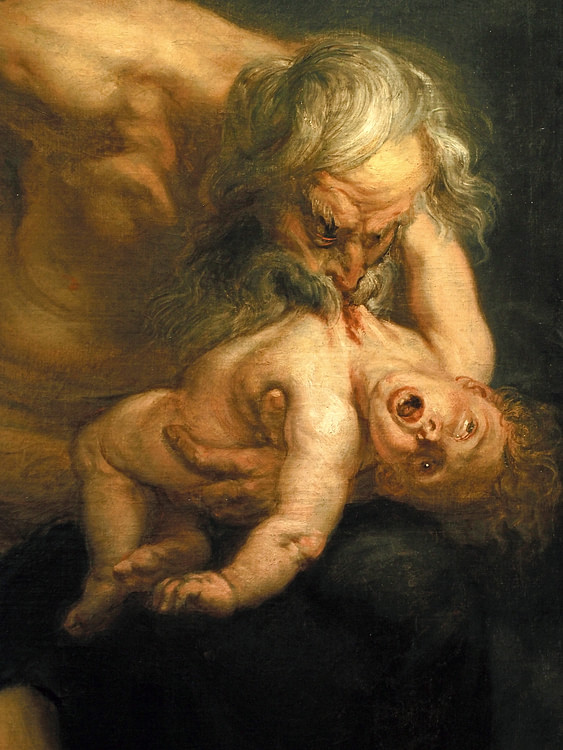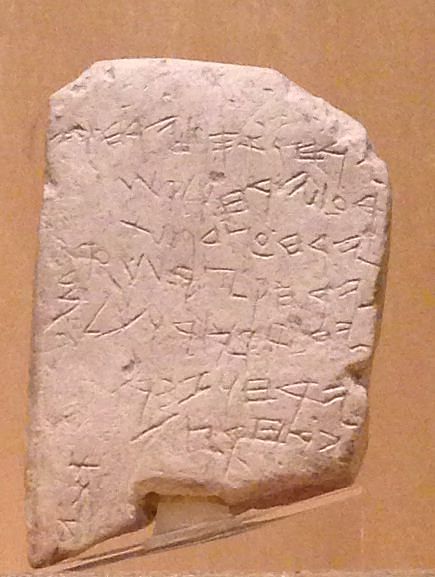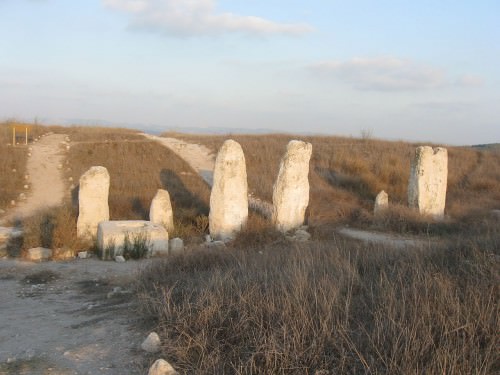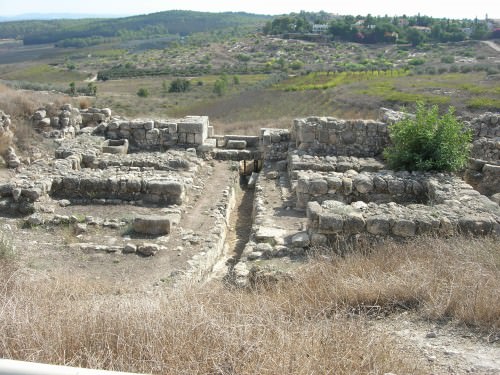Saturn › Gezer » Ancient origins
Articles and Definitions › Contents
- Saturn › Who Was
- Gezer › Antique Origins
Ancient civilizations › Historical and archaeological sites
Saturn › Who Was
Definition and Origins

Saturn (Saturnus) was a Roman god with a similar history to Cronus from Greek mythology. Often depicted in art wielding a scythe he was considered an agricultural god, especially associated with seed-corn. The Saturnalia festival, named after him, was one of the most important and lively events in the Roman calendar and the god also had a major temple dedicated to him in the Roman Forum of Rome.
GREEK ORIGINS
Greek and Roman mythology are interwoven, and to many, they appear to be one and the same. While the names of the gods and goddesses may be different - Zeus morphed into Jupiter while Hades became Pluto - their diverse roles and positions in society are fairly consistent. From the time the Romans first made contact with the Greeks, their society would never be the same, becoming Hellenized, albeit reluctantly. The Romans admired all that was Greek. The wealthiest and most powerful families of Rome would even hire Greek tutors for their male children. The Republic's (and later Roman Empire ’s) literature, art, philosophy and foremost, religion would be changed forever. One of the best and earliest examples of this religious transformation would revolve around an outcast - a god driven out of Greece but finding a home on the hills of Rome.His name was Saturn.
Some authors believe Saturn existed in Roman mythology long before the “invasion” of Greek religion and associate him with the Etruscan god Satre; however, whether this is true or not is entirely speculative. As the Greek religion became more Romanized, Saturn or Saturnus, often pictured holding a scythe, became more closely associated with the Greek god Cronus, the lord of the universe and the god who devoured his own children. He was son of Uranus (sky) and Gaea (earth). After Zeus and his brothers ( Poseidon and Hades) became victorious over the Titans, Saturn was expelled from the home of the Greek gods, Mt. Olympus.
ACCORDING TO ANCIENT MYTH, SATURN RULED LATIUM WISELY DURING ITS GOLDEN AGE.
SATURN & LATIUM
According to legend, Saturn settled in Latium on the future site of Rome. His arrival was welcomed by the Roman god Janus, the two-faced deity, the god of the beginnings and ends. Saturn quickly established himself there, even founding the nearby city of Saturnia. According to ancient myth, Saturn ruled Latium wisely during its golden age, a time of great prosperity and peace. It was during this time that he became more closely associated with agriculture (as a god of seed-corn) - hence the reason for his typical depiction in art holding a scythe. He instructed the people on the basic principles of farming and viticulture (the production of grapes). He also helped the locals to rid themselves of their “barbaric” customs and instead adopted a more civic and moral lifestyle.
THE SATURNALIA
While historians argue over the origins of Saturn and his role in Roman mythology, his place in Roman history is remembered for two items: his temple and his festival - the latter being one of the most anticipated festivals of the many on the Roman calendar. His temple, built around 498 BCE, was located at the foot of Capitoline Hill and housed the Roman treasury as well as the records and decrees of the Roman Senate. Falling into disrepair, it would be rebuilt during the reign of Emperor Augustus. His festival, the Saturnalia, was celebrated in December from the 17th to the 23rd and was connected to the winter grain sowing. (There are some who place the festival in August). Although Emperor Augustus reduced the length of the festival to three days - Caligula and Claudius later raised it to five - most people ignored the decrees and still celebrated it for the full seven days. As part of the calendar of Numa, the second king of Rome, the festival immediately preceded the festival of Ops, Saturn's partner or consort and the goddess of the harvest - she became associated with the Greek goddess Rhea.Saturn was also linked to another ancient Italian deity, Lua.

Temple of Saturn, Rome
The festival was like many others where time was spent eating, drinking, and gaming - there were plenty of games and banquets (Christian historians question whether or not there were gladiators and human sacrifice). Presiding over the festival was a mock king, the King of Misrule, or Saturnalicius princeps. Gifts were exchanged, usually candles or pottery figurines.However, during the week of celebration, slaves were awarded a unique opportunity. They were given a limited amount of freedom. For one, they did not have to wear the traditional felt hat or pilleus. Leisure attire was also permitted and, uniquely, the master and slaves reversed roles. Slaves gave orders to the masters, and masters waited on slaves. The festival would endure into the Christian era when it would assume a new identity and name - Brumalia.
Today the festivals and celebration are long gone and, like many of the other Greek and Roman deities, their names belong only on the pages of a dusty, old book. However, a few, like Saturn have achieved some sense of immortality. We remember Saturn in two ways, for one he ends our busy work week - Saturday. And, as we look to the sky, on occasion, we can see the sixth planet from the sun - Saturn.
Gezer › Antique Origins
Definition and Origins

Gezer is an ancient city and archaeological site located in central Israel where the central mountains meet the northern Shephelah, about 10 km southeast of the city of Ramleh. According to the Hebrew Bible, Gezer was one of the great citiesfortified by Solomon, in addition to Jerusalem, Megiddo, and Hazor (1 Kings 9:15–17).
Gezer is located on a manmade mound or tell in Arabic—transliterated as tel in Latin characters from Hebrew - consisting of more than 25 layers of debris and soil, representing the material remains of successive periods of human occupation. The mound of Tel Gezer measures about 650 meters long east to west, by 200-250 meters wide, with hills on the east and west ends and a dip or "saddle" in between.
The site was inhabited from about 3500 BCE through the Roman period. It remained a small, unfortified settlement until the Middle Bronze Age (c. 2000-1500 BCE) (the "MB"), when stone fortifications were first constructed. Additional fortifications and monumental structures were built in the Iron Age, sometime from the 10th to the 8th century BCE, and the site continued to be inhabited until the Roman period.
GEOGRAPHY & EXCAVATIONS
Strategic location
Gezer occupied a strategic geographical position in antiquity. It was located just to the east of the Via Maris that ran from Egypt north along the sea and then east past Megiddo and on to Damascus. It was also on the "trunk road" that ran east through the hills to Jerusalem and on to Jordan. The trunk road ran around the north of the tell into the Aijalon Valley where the Hebrew Bible says that the moon "stayed" when Joshua commanded it to do so (Joshua 10: 12–13).
GEZER OCCUPIED A STRATEGIC GEOGRAPHICAL POSITION IN ANTIQUITY. IT WAS LOCATED JUST TO THE EAST OF THE VIA MARIS THAT RAN FROM EGYPT TO DAMASCUS.
Excavations of Tel Gezer
The site has been excavated several times in the past century. It was first excavated by the Irish archaeologist RAS Macalister for the Palestine Exploration Fund (PEF) in the early 20 th century CE, and then, more than 50 years later, by a joint expedition of the Hebrew Union College Biblical and Archaeological School (HUC) and the Harvard Semitic Museum in the 1960s CE and 1970s CE and by archaeologists from the University of Arizona in 1984 CE and 1990 CE. As of 2015 CE, it is currently being excavated by a team from the Tandy Institute for Archaeology at the Southwestern Baptist Theological Seminary (SBTS), and by a group from the Moskau Institute for Archaeology at the New Orleans Baptist Theological Seminary (NOBTS) which is excavating the Gezer Water System.
EARLIEST OCCUPATION OF THE SITE
The earliest evidence of occupation of Tel Gezer dates to the Early Bronze Age (EB), probably in the period from about 3500–3250 BCE. The period was called "Ghassulian-Beersheba," and during this time, the inhabitants initially lived in caves. Later, when they moved to other dwellings, they used the caves as tombs and crematoria. The tell was occupied throughout the EB, but the settlement was destroyed at the end of the EB in the 24 th century BCE.
THE MIDDLE BRONZE AGE (2000–1500 BCE)
In the earliest period of the MB, called the "Middle Bronze Age I" (MBI), the tell was again inhabited, as indicated by the presence of MBI pottery in the archaeological record. In the second part of the MB, called "Middle Bronze Age II" (MBII), around 1875–1850 BCE, the process of building the city began. Large fortifications were built throughout the site, including stone walls and towers, a glacis, and a gate on the western hill. The fortified city of the MB was destroyed in about 1500 BCE at the end of the MB.

The MB Canaanite gate after excavation.
The High Place
In the latest part of the MB II, called "Middle Bronze Age IIC" (MBIIC), ten stone columns, 1.65 to 3.25 meters tall, called the "High Place," were built at Gezer. They were also called "standing stones," "standing stelae," or " Massebot." The purpose of the stones of the High Place is not known, but it has been suggested that they were used for cultic purposes or perhaps as altars, possibly, for purposes of infant sacrifice. However, the longtime excavator of Tel Gezer, William G. Dever, recently rejected the last suggestion, pointing out that although there was evidence of infant sacrifice, it was found in a different stratum from that of the High Place. Instead, Dever suggested, the stones might have been used to memorialize a treaty among ten tribes in the area.

The standing stones of Gezer's
The Tel Gezer Water System
A sophisticated water system was constructed at Gezer in the MB, perhaps as early as 2000 BCE. The water system was designed to allow the city's inhabitants to reach a source of water within the city's walls in relative safety from enemies. It included a long sloping shaft that allowed people to walk down to a basin where water collected.

The entrance to Gezer's water system during the 2011 excavations.
THE LATE BRONZE AGE
In the Late Bronze Age (LB), Gezer was rebuilt, but the city was conquered several times during the period by Egyptian armies and apparently came under Egypt's control. An inscription dating to 1468 BCE indicates that Gezer was conquered by Thutmose III. Then during the reign of Thutmose IV in the late 15 th century BCE, the king of Gezer was summoned to appear before the pharaoh. The Egyptians were also said to have taken prisoners in Gezer and sent them to Egypt, according to a stela of Thutmose IV, a cuneiform letter found at Gezer by Macalister and another ancient inscription. Then in the late 13th century BCE, Gezer was captured and destroyed by the pharaoh Merneptah, according to the pharaoh's stela. In the 12 th century BCE, the Philistines conquered Gezer and took control of the city.
REFERENCES IN THE HEBREW BIBLE
Gezer is mentioned often in Biblical accounts whose setting is the LB or the Iron Age, including the following:
- Joshua 10:33
- Joshua 16:10
- Joshua 16:3
- Joshua 21:21
- Judges 1:29
- 2 Samuel 5:25
- Chronicles 20:4
- 1 Kings 9:15–17
The Time of Joshua
According to the Hebrew Bible, Gezer's king Horam aided Lachish and was defeated by Joshua, but Gezer continued to be inhabited by Canaanites (Joshua 10:31–33 and 16:3; Judges 1:29).
The Time of David & Solomon
According to the Biblical account, many of David's battles with the Philistines were fought around Gezer (1 Chronicles 14:16 and 20:4, and 2 Samuel 5:25). It has been suggested that David did not capture Gezer - or Ashdod, Ashkelon or Gaza - because he did not want to interfere with Egypt's involvement in these cities.
A Biblical account says that Gezer was destroyed by an Egyptian pharaoh in the 10 th century BCE (possibly the 21 st dynasty pharaoh Siamun) (1 Kings 9:16). The city was then given to pharaoh's daughter as a dowry when she married Solomon, and at that time, Gezer became an Israelite city, and "Solomon rebuilt Gezer" (1 Kings 9:15–17).
The Hebrew Bible also states that Solomon used forced labor "to build the wall of Jerusalem, Hazor, Megiddo, [and] Gezer" (1 Kings 9:15). In the Iron Age, a six-chambered gate was built on the saddle. But archaeologists disagree on the dating of the gates. During or shortly before the HUC-Harvard excavation, Yigael Yadin re-examined Macalister's dating of the gate at Gezer (which Macalister had incorrectly dated to the Maccabee period) and attributed the Gezer gate, as well as those at Megiddo and Hazor, to Solomon in the 10 th century BCE.
However, other archaeologists have re-dated the gates and certain other massive structures to later dates - in the 9th and the 8 th centuries BCE. Nevertheless, for the moment, the directors of the current expedition at Gezer continue to maintain that the gate at Gezer dates to Solomon and the 10 th century BCE, as Yadin said.

The remains of the six-chambered gate.
THE IRON AGE
During the Iron Age, Gezer was attacked many times. In addition, it was again conquered by Egypt, according to an inscription in Karnak dating to 918 BCE. Famed American archaeologist William F. Albright, longtime director of the American School for Oriental Research in Jerusalem in the 1920s CE and 1930s CE, stated that the pharaoh Shishak was responsible for the attack in the late 10 th century BCE. Albright went on to say that Gezer was then abandoned. However, pottery evidence suggests that the city continued to be inhabited by a substantial population in the 8 th and 7 th centuries BCE.
In the second half of the 8 th century BCE, the Assyrian king Tiglath-Pileser III (745–728 BCE) attacked and laid siege to Gezer. Then, after the Northern Kingdom of Israel was conquered by the Assyrians in the late 8 th century BCE, Gezer became part of the Kingdom of Judah. Finally, at the end of the 7 th and beginning of the 6 th century BCE, Gezer, like Jerusalem, was captured by the Neo-Babylonian king Nebuchadnezzar.
Many of the people of Judah were carried off to the lands to the east controlled by the Neo-Babylonians, and they remained there for several decades during the Babylonian Exile. However, beginning in 539 BCE, many of them returned to Judah after they were freed by an edict issued in that year by the Persian king, Cyrus the Great, who had conquered the Neo-Babylonians.
THE PERSIAN & HELLENISTIC /MACCABEAN PERIODS
After the Babylonian Exile, the former Kingdom of Judah, became the Persian province of "Yehud." Then, in the Hellenistic Period, the province became part of the Hellenistic Ptolemaic kingdom of Egypt. A seal found in Gezer shows that the city was part of the province of Yehud in the Persian and Ptolemaic periods.
In the Maccabean period, Gezer was captured by the Maccabees, and the Hasmonean kings Simon Maccabaeus and John Hyrcanus lived there, after which the city may have been temporarily deserted.

One of the boundary stones from the Roman period.
Herodian, Roman & Byzantine Periods
In the Herodian and Roman periods in the first century CE, Gezer seems to have been part of the estate of a Greek landowner named Alkios. It was apparently farmed by Jewish settlers who lived on the land. The inscribed boundary stones may belong to the Roman period. Tel Gezer may have been uninhabited after this, but in the Roman and Byzantine periods, it was apparently used as the location of tombs and structures other than dwellings.
LICENSE:
Article based on information obtained from these sources:with permission from the Website Ancient History Encyclopedia
Content is available under License Creative Commons: Attribution-NonCommercial-ShareAlike 3.0 Unported. CC-BY-NC-SA License